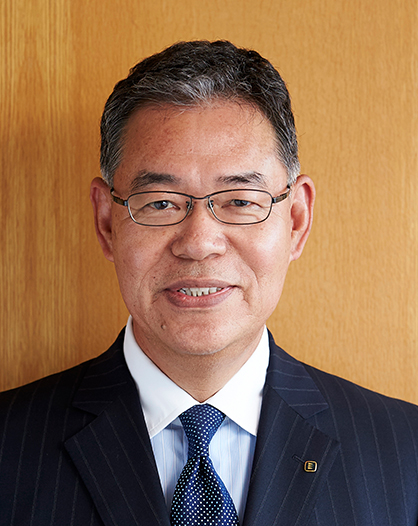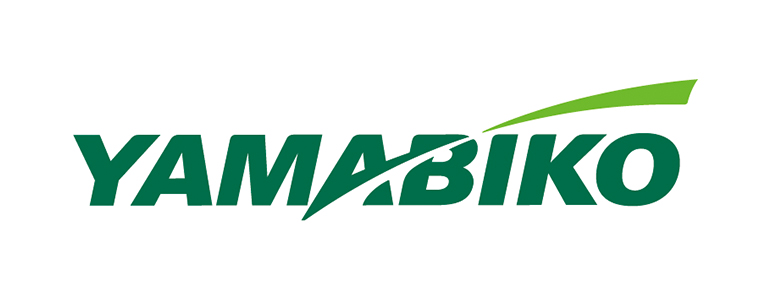| YAMABIKO CORPORATION (6250) |
|
||||||||
Company |
YAMABIKO CORPORATION |
||
Code No. |
6250 |
||
Exchange |
TSE 1st Section |
||
Industry |
Machinery (Manufacturing) |
||
President |
Yoshiaki Nagao |
||
Address |
1-7-2, Suehiro-cho, Ome-shi, Tokyo, Japan |
||
Year-end |
End of March |
||
URL |
|||
* The share price is the closing price on June 14. The number of shares issued was taken from the latest brief financial report.
ROE and BPS are the actual values for the previous term. * FY December 2017 lasts for only 9 months due to the change of accounting periods. |
||||||||||||||||||||||||
|
|
*The forecast is from the company. It undertook a 1:4 stock split as of October 1, 2015. EPS and DPS have been retrospectively adjusted.
*From the FY 3/16, net income is profit attributable to owners of the parent. Hereinafter the same shall apply. * FY December 2017 lasts for only 9 months due to the change of accounting periods. This report introduces YAMABIKO CORPORATION's Earnings Results of Fiscal Year March 2017, Points of "2019 Medium-term Management Plan," Interview with President Nagao and so on. |
| Key Points |
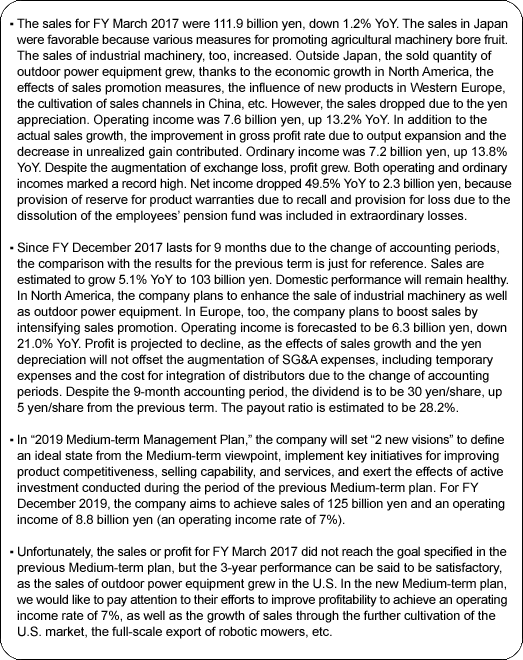 |
| Company Overview |
|
KIORITZ CORPORATION was established in 1947 in Tokyo and originally called KIORITZ AGRICULTURAL EQUIPMENT CORPORATION. It has been a leading company in both agricultural equipment business through which they developed "Japan's first speed sprayers" and outdoor power equipment business through which they developed "Japan's first motorized backpack trimmers" and "the world's first handheld power blowers". Furthermore, since its establishment, it has been focusing on self-development of engines for outdoor power equipment. The accumulative number of engines produced in 2008, before the merger, was about 40 million. Shindaiwa Corporation was established in 1952 in Hiroshima and was originally called Asamoto Precision Manufacturer. It developed "Japan's first electric chain saws" for the outdoor power equipment business, and manufactured and sold engine generators and engine welders for the industrial machinery business. Its strength was high technological development capabilities, as can be seen in the development of the world's first mixed fuel 4-cycle engine. In the late 1990s, with growing concern about global warming caused by greenhouse effect gas, and as engine's emission gas control became stricter in the West, especially in the US, research and development expenses increased to comply with the new regulations. In the 2000s, the medium and small-sized companies that could not afford these expenses went through rapid industry restructuring on a global scale in the outdoor power equipment industry. Moreover, the business environment became further uncertain due to a flood of cheaper products from newly emerging countries and diversification of customers' needs. Under these circumstances, the two companies concluded a business and capital alliance agreement in May 2007 on the premise of future business integration in order to strengthen the vitality to survive and win the intensifying competition. In December 2008, YAMABIKO CORPORATION was established as a joint holding company to achieve better efficiency and expansion for all its businesses including development, manufacturing, logistics, sales and management. In October 2009, YAMABIKO CORPORATION conducted an absorption-type merger of Kioritz and Shindaiwa and became the current business entity. The company name "YAMABIKO" derives from the mountain god, "Yamabiko". Its corporate philosophy is to "create the bridge that bonds people and nature with the future". This expresses the Company's willingness to contribute to the conservation and improvement of the nature and environment. "Essence", which incorporates both "Purpose of Existence" and "Code of Conduct", expresses in a single word what YAMABIKO Group aims to be as a company, and the essence of its corporate activities. "Purpose of Existence" sets out the role and responsibilities of YAMABIKO Group in society, and makes a commitment to this. "Code of Conduct" defines the attitude of each YAMABIKO Group employee in relation to their work. 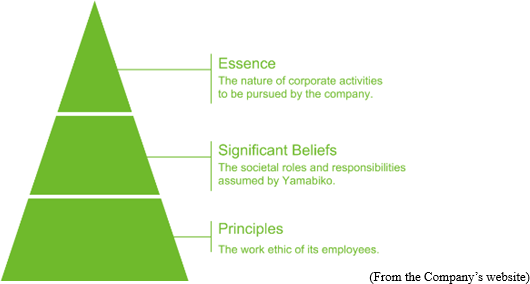 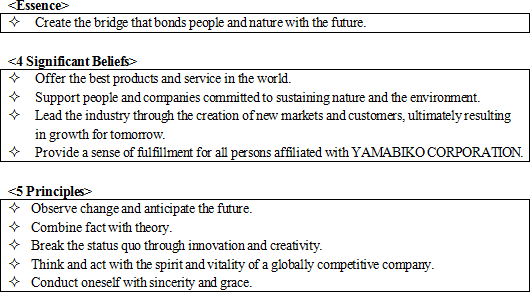 President Nagao disseminates messages that are based on "Essence", "Purpose of Existence" and "Code of Conduct" at various occasions. They are also making daily efforts so that the corporate philosophy would lead to each employee's actual activities in each workplace. * Profile of President Yoshiaki Nagao
President Yoshiaki Nagao was born in February 1953 (Age 64). Since his childhood, he enjoyed "creation" such as building plastic models. When he was in the middle school, his interest grew in automobiles, especially those made in the US. He majored in "combustion engineering" in graduate school, where he studied engines. He began working at KIORITZ CORPORATION in April 1978. At KIORITZ, he worked at the research department. He was involved with research and development of various engines, especially chain saws engines, under the corporate culture that supported the employees' spirit to find and work on the issues of their interest. Instead of focusing on his research only in the lab, he went out to the mountains and interviewed woodsmen who were the users of their products to hear opinions and identify the demands in detail. After working in the technology area for most of his time at KIORITZ, he was appointed as President and CEO of ECHO Incorporated, an affiliate of KIORITZ in the US in February 2006. His focus at ECHO Incorporated was to observe the actual situation of the emission gas control regulations in the US, to find measures to meet the regulations, and to enhance the users' satisfaction. During the merger process of KIORITZ and Shindaiwa, he facilitated fast and drastic organization of the local sales routes. He recalled, "It was an important step to diversify my work". After the establishment of YAMABIKO CORPORATION, he managed to implement smooth integration as a board director / managing officer / industrial machinery division officer in Hiroshima where the head office of Shindaiwa Corporation was located. In June 2011, he was appointed CEO and President of YAMABIKO CORPORATION. The company recognizes that there are two global manufacturers of outdoor power equipment in Europe (Germany and Sweden). 1. Segment
YAMABIKO Group operates businesses in three sectors: Outdoor power equipment, Agricultural machinery and Industrial machinery.The reporting segments are "Outdoor power equipment/Agricultural machinery", "Industrial machinery" and "Others". (Disclosed sales data are divided into four: Outdoor power equipment business, Agricultural machinery business, Industrial machinery business, and Others.) From FY December 2017, the company uses new business segments as follows. 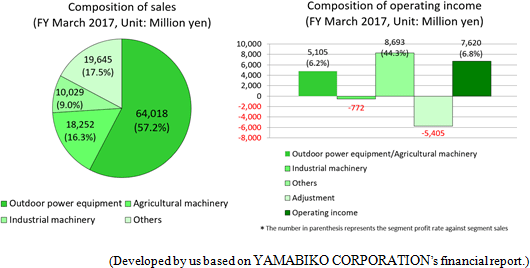 "Outdoor power equipment business"
YAMABIKO CORPORATION manufactures and sells handheld or backpack-style forestry and landscape maintenance machinery powered by small internal combustion engines. The main products include chain saws, trimmers, power blowers, hedge trimmers, etc. Based on the accumulated experiences and know-how and excellent development capabilities that meet the customers' needs, YAMABIKO CORPORATION continues to produce high performance, highly durable and high quality engines. 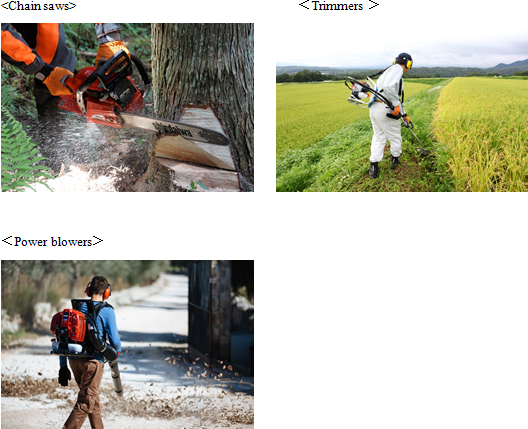 (Gasoline engine system)
The engines for outdoor power equipment such as chain saws and trimmers are mainly 2-stroke gasoline engines. As described later, the Company's excellent capability to develop engines is one of their most important features/strengths. Brief information concerning the Company's engines is provided below because knowing the gasoline engine system and characteristics of each engine type helps to understand the business of the Company, Basically, a gasoline engine generates power by moving the piston down with the combustion of gasoline through the following 4 steps.  The gasoline engine is largely categorized in two types (2-stroke engine and 4-stroke engine), depending on the number of reciprocating motion by piston to complete "1 cycle" of the 4 steps. "2-stroke engine"
One power cycle is completed by 2-stroke. In other words, a power is generated by "1 piston reciprocating motion, 1 crankshaft revolution". First stroke (piston moving up): "Intake" and "compression" of air-fuel mixture occur. Second stroke (piston moving down): Piston moves down due to the "expansion" of air-fuel mixture and "exhaustion" occurs later. 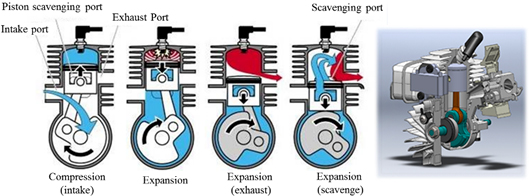 "4-stroke engine"
One power cycle is completed by 4-stroke. A power is generated by "2 piston reciprocating motions, 2 crankshaft revolutions". First stroke (piston moving down): "Intake" of air-fuel mixture occurs. Second stroke (piston moving up): "Compression" of air-fuel mixture occurs. Third stroke (piston moving down): Piston rapidly moves down as a result of "expansion". Fourth stroke (piston moving up): Combusted gas is "exhausted". 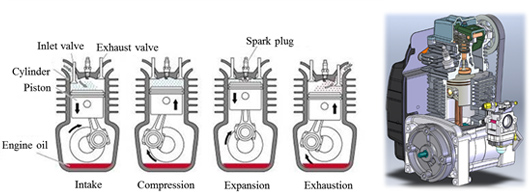 On the other hand, a 2-stroke engine has a larger ratio of burning engine oil and fuel in order to make smooth piston motion and blow-by of air-fuel mixture. This means it releases more harmful substances in the exhaust gas as compared with a 4-stroke engine. However, because of its simple structure and smaller number of parts, the 2-stroke engine can be smaller and lighter. The overhaul is also easier for the same reasons. Therefore, a 2-stroke engine is the most appropriate engine for outdoor power equipment. "Agricultural machinery business"
YAMABIKO CORPORATION manufactures and sells pest control equipment for Japan and agricultural harvesting equipment for North America. Its major products include pest control equipment (speed sprayers, mounted equipment for cropland pest control, boom sprayers), sloop mower, soy and potato harvesters, etc. The Company purchased a Belgian venture company, "Belrobotics SA" in November 2014. It is specialized in development, manufacturing and sales of robotic mowers for business use. (In Jan. 2017, Belrobotics was renamed Yamabiko Europe SA, for the purpose of enhancing sales in Europe.) YAMABIKO CORPORATION's technological strengths in this business segment are KIORITZ's blowing, spraying, and pumping technology as well as technology to create small and light equipment. These technological capabilities have been built up over many years at KIORITZ. 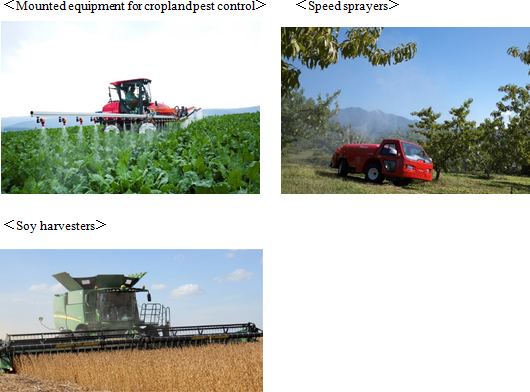 "Industrial machinery business"
YAMABIKO CORPORATION manufactures and sells equipment for construction, civil engineering and iron works. Its major products include generators, welders, lighting equipment, cutting machines and high-pressure washers. Technological strengths in this business segment are established by long years of R&D which began at the time when YAMABIKO CORPORATION started business as Shindaiwa, and such strengths can be found in alternator designing capability improved by their efforts for alternative current motor development, as well as technologies for electronic control and noise prevention. 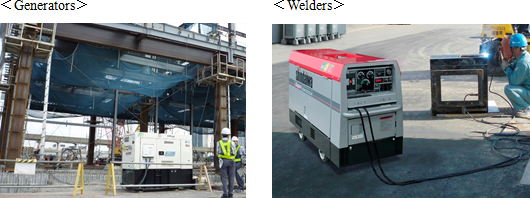 "Others"
The Company manufactures and sells accessories and the parts for after purchasing service for various machines and equipment. As shown in the graph on Page 5, the profitability in this segment is the highest in all segments. 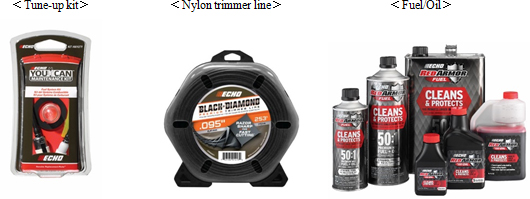 2. Brand
YAMABIKO CORPORATION was established based on the integration of two companies. The products of both companies are well recognized both in Japan and overseas for many years. Therefore, YAMABIKO CORPORATION maintains the brand names as KIORITZ, Shindaiwa, and ECHO. YAMABIKO CORPORATION is proactively investing in marketing as well as exploring new sales routes to enhance its brand values.  3. Development structure
Each business segment is working on development with a focus on the following priority issues.
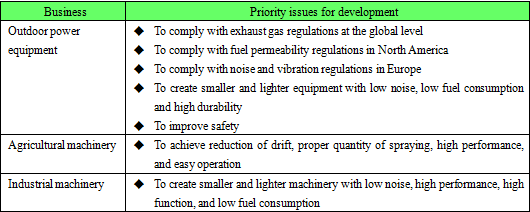 In addition, the Company is conducting research on control technology in the field of electronic control. 4. Production structure
The Company has 3 plants (Yokosuka, Morioka, and Hiroshima) and 4 production related subsidiaries in Japan and a total of 7 production related subsidiaries in the USA, Belgium, China and Vietnam.
5. Sales route and sales methods
The Company supplies its products in over 90 countries for about 28,000 stores. More than 60% of the sales are from overseas sales. 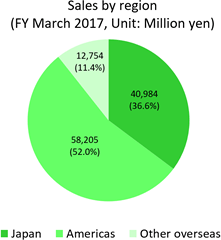 <Domestic market>
7 sales subsidiaries sell the products to distributors, Zen-Noh (National Federation of Agricultural Cooperative Associations), home improvement retailers, and construction machinery rental companies, etc. Through them, the products are supplied to the end users including farmers/foresters, companies in the construction, civil engineering and iron industries and landscapers. The Company presents their products in exhibitions in collaboration with distributors and dealers and facilitates sales through demonstration and test drive. Furthermore, the Company accompanies dealers to visit end users to understand their needs and utilize the information for product development. <North American market>
ECHO Incorporated Group, one of the Company's subsidiaries, sells the products to The Home Depot (*) and other distributors, through which the products are supplied to the end users such as landscapers, homeowners, farmers/foresters, and companies in the construction/civil engineering industry.
*The Home Depot
The Home Depot, Inc. is the world's largest home improvement retailer and construction products and services. It was established in 1978. Sales in 2015 were US$88,500 million (approx. ¥9.7 trillion) and net income was US$7,000 million (approx. ¥770 billion). It has 2,274 stores in the US, Canada and Mexico. It is listed on the New York Stock Exchange. (Excerpted from the company's website) In the Central and South American market, ECHO Incorporated, one of the Company's subsidiaries, sells the products to the distributors of each country, and then, the products are supplied to the end users through dealers. In Europe, Asia and other areas, YAMABIKO CORPORATION sells the products to the distributors in each country. The overseas dealers display the products by brand, and salesperson conducts person-to-person sales while understanding the needs of the end users. The home improvement retailer also displays the products by type and price. The end users purchase the products based on the needs, budget and image they have from advertisement, etc. (1) Unique production and technological capabilities and vertically integrated production capabilities
The most important characteristics and strengths of the Company are the "unique production and technological capabilities and vertically integrated production capabilities". Their mainstay 2-stroke engines that are mounted to the outdoor power equipment are manufactured by an integrated production system solely by the Company from development, procurement of aluminum, molding, parts production, processing to assembly, which is said to be unique anywhere in the world. The power sources for the agricultural machinery and industrial machinery are also engines, but they are mostly procured externally. The Company solves various issues with their unique technologies including iron plating and electric discharge processing. This is resulting in the quality improvement and production capacity improvement of the Company. Specifically, the Company has established the following technologies. <Example 1: Iron plating>
Plating is a surface covering method in which the surface of a metal is covered by a thin layer of another metal. For engine production, inside of the cylinder should be plated to avoid abrasion caused by friction with a piston. The conventional method is to use chrome plating from durability and cost perspectives. However, chrome plating gives negative impact on the environment. Its production efficiency is also low. Therefore, there was an increasing demand for different materials for plating. The Company has been working on "iron plating" since 1978 to reduce environmental load. Initially, they could produce only hundreds per day. However, as a result of improved productivity, enhanced plating precision, and reduction of environmental load, the Company now has the iron plating technology that does not require finish processing. Their technology has drastically smaller environmental load. Furthermore, their daily production capacity increased significantly, reaching thousands. The Company holds patents related to iron plating. <Example 2: Electric discharge processing>
As described above, a 2-stroke engine requires less number of parts and has a simpler structure as compared to a 4-stroke engine. Therefore, it is most suitable for the "handheld" and "backpack-style" outdoor power equipment. However, it releases some fuel mixed gas. In order to respond to the increasingly strict exhaust gas regulations globally, the Company was faced with a challenge to control the flow of the fuel mixed gas for efficient burning. In order to achieve it, the Company explored the production methods to modify the internal shape of the cylinder (by installing a wall between the fuel mixed gas passage and internal shape of the cylinder). A "wall" can be created by die-casting (*), but it requires a horizontal hole to lead the fuel mixed gas to a combustion chamber. With die-casting, it was impossible to create a horizontal hole. It was also difficult to carry out machining due to small space in the chamber. The Company came up with the idea of using "electric discharge processing (*)" to create a form while taking advantage of die-casting. Although electric discharge processing enabled to create complicated forms, it was costly due to long processing time and high electrode consumption. The Company conducted research on processing conditions for a large volume production and developed designs of special electrode form. As a result, it succeeded in producing a large volume of products, by shortening processing time, saving personnel, lowering the cost of electrode and enhancing efficiency. Having obtained three patents related to electrode processing, the Company has established the unique technology that cannot be imitated by other companies.
(*) Die-casting
Die-casting is one of the metal mold casting methods. By injecting melted metal in a metallic mold, a large amount of casting with high precision can be produced within a short period of time. It enables to create a thin product at low cost. (*) Electric discharge processing Electric discharge processing is a machine processing method to remove a part of the surface of a non-processed work piece through repeated electrode discharge at short cycles between electrode and the non-processed work piece. It enables to cut out complicated outline on extremely hard steel. While many companies in the world are forced to leave the industry because they cannot address these issues, YAMABIKO CORPORATION continues to make further development as a leading manufacturer. (2) Unique research and development capabilities for each business segment
The Company's capability to address environmental issues is high. The Company possesses one of the highest number of US Environmental Protection Agency (EPA)-accredited engines in the world.Furthermore, not only for outdoor power equipment, the Company also has unique research and development capabilities for the agricultural machinery and industrial machinery. Based on the technological capacities that have been accumulated by KIORITZ and Shindaiwa for many years, the Company is further brushing up the capabilities. (3) Extensive product lineup and expansion of sales network
The Company has an extensive lineup of products that meet various needs of the customers in each of the three business segments. It also currently supplies the products to about 28,000 stores in more than 90 countries across the world. As a result of merging KIORITZ and Shindaiwa, YAMABIKO CORPORATION's product lineup and sales network were further expanded. (4) Excellent technical support system
The Company also provides excellent technical support in order to enhance credibility of the products and strengthen the relationships with distributors and dealers. It has offered 115 service schools in 15 countries within 2 years from April 2015 to March 2017. (5) High product share
By demonstrating the above-mentioned characteristics and strengths (1) to (4) in an integrated manner, the Company is becoming highly competitive at a global level. For the outdoor power equipment business, the Company has the top market share (more than 30%) in Japan and is ranked high in North America, the largest market.
 In the Medium-term Management Plan, the company aims to achieve an ROE of 10% or over in FY December 2019. |
| Fiscal Year March 2017 Earnings Results |
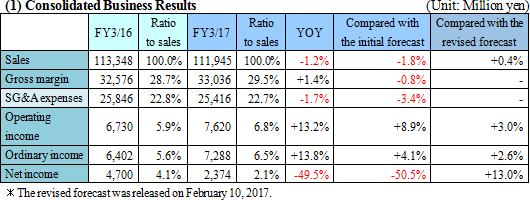 Sales dropped, while operating income grew.
Sales were 111.9 billion yen, down 1.2% YoY. The sales in Japan were favorable because various measures for promoting agricultural machinery bore fruit. The sales of industrial machinery, too, increased. Outside Japan, the sold quantity of outdoor power equipment grew, thanks to the economic growth in North America, the effects of sales promotion measures, the influence of new products in Western Europe, the cultivation of sales channels in China, etc. However, the sales dropped due to the yen appreciation. Operating income was 7.6 billion yen, up 13.2% YoY. In addition to the actual sales growth, the improvement in gross profit rate due to output expansion and the decrease in unrealized gain contributed. Ordinary income was 7.2 billion yen, up 13.8% YoY. Despite the augmentation of exchange loss, profit grew. Both operating and ordinary incomes marked a record high. Net income dropped 49.5% YoY to 2.3 billion yen, because provision of reserve for product warranties due to recall and provision for loss due to the dissolution of the employees' pension fund were included in extraordinary losses. 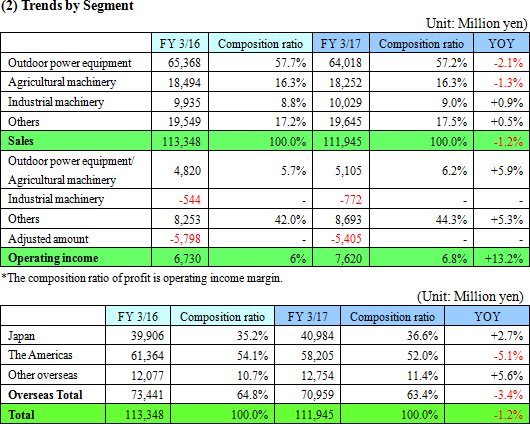 ◎ Outdoor power equipment
Sales were 64 billion yen, down 2.1% YoY.(Japan) The performance of trimmers, which are their major products, was favorable, thanks to the cultivation of sales channels to home improvement retailers, but the sales of chain saws dropped due to the sluggishness of the market. Consequently, the sales in Japan are nearly unchanged from the previous term. (The Americas) Due to the yen appreciation, sales in yen declined. The performance in Latin America remained sluggish, but the company was able to sell more products in North America, which is their primary target area, by taking limited-time-only pricing measures, advertising products actively, expanding sales channels, and so on. (Other overseas markets) In Europe, the company actively promoted its products targeting distributors and released new chain saws and trimmers, increasing sales significantly. Despite the yen appreciation, sales grew, thanks to the cultivation of sales channels in the Chinese market. 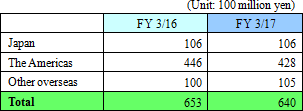 ◎ Agricultural machinery
Sales were 18.2 billion yen, down 1.3% YoY.(Japan) The sales of speed sprayers declined through the recoil from the special demand due to the emissions control in the previous term, but the sales of sloop mowers and ordinary mowers, whose demand is growing, increased, and equipment for high-place work, chipper shredders, etc. sold well to mainly fruit farmers. Consequently, sales grew. (Overseas) Sales dropped significantly, because of the yen appreciation and the decrease in the sales volume of large harvesters due to the lingering downturn of commodity prices. 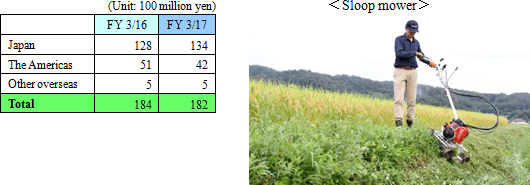 ◎ Industrial machinery
Sales were 10 billion yen, up 0.9% YoY.(Japan) The sales of welders decreased, but the sales of generators, which are their main products, increased thanks to the infrastructure development projects promoted by the government and the establishment of routes for rental of construction machinery, and the performance of lighting equipment, which was sluggish in the previous term, recovered. Consequently, sales rose. (Overseas) Sales dropped, because the results in North America and Australia were unfavorable due to the slump of prices of resources. 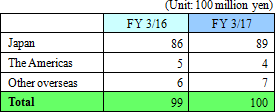 ◎ Others
Sales were 19.6 billion yen, up 0.5% YoY.(Japan) Sales grew because the company implemented measures for promoting the sales of accessories actively. (Overseas) Quantity sold increased in North America and Europe, which are main target areas, due to favorable weathers, but sales declined due to the effects of exchange rates. 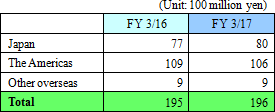 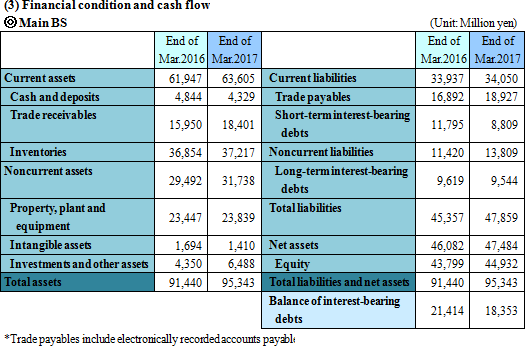 Current liabilities were nearly unchanged, as trade payables augmented and short-term interest-bearing debts decreased. Since provision for loss due to the dissolution of the employees' pension fund amounting to 2.8 billion yen was posted, noncurrent liabilities rose 2,389 million yen from the end of the previous term. Consequently, total liabilities were 47,859 million yen, up 2,502 million yen from the end of the previous term. Due to the growth of retained earnings, net assets increased 1,402 million yen from the end of the previous term to 47,484 million yen. As a result, equity ratio declined 0.5% from the end of the previous term to 49.8%. The balance of short and long-term debts was 18,353 million yen, down 3,061 million yen from the end of the previous term. 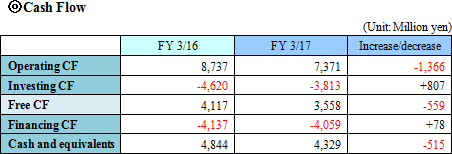 Investing CF increased due to the decrease in purchase of property, plant, and equipment and intangible assets, and the surplus of free CF declined. Financing CF was nearly unchanged. The cash position degraded. (4) Topics
In May 2017, the company announced that it would establish affiliates in Suzhou, Jiangsu, China. ◎ Establishment of affiliates in China The affiliates are a production facility for agricultural machinery targeted at the Chinese market and a logistics center for selling outdoor power equipment inside China. ECHO MACHINERY, which is a 100% subsidiary of YAMABIKO CORPORATION, will finance them fully. They are scheduled to be established on July 1, 2017, and start operation on September 1, 2017. |
| Fiscal Year December 2017 Earnings Estimates |
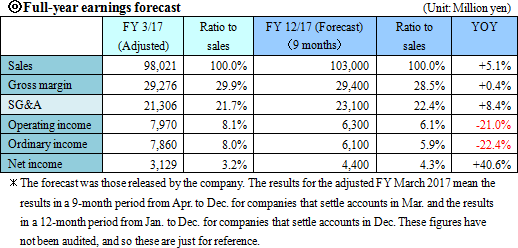 Sales virtually grew, and final profit increased.
From this term, the company will settle accounts in Dec., and so the comparison from the results for the previous term is just for reference.Sales are estimated to be 103 billion yen, up 5.1% YoY. The performance in Japan will remain healthy. In North America, the sales of outdoor power equipment and industrial machinery are forecasted to grow, as sales channels have increased and the market related to shale gas is recovering somewhat. In Europe, too, sales are projected to rise thanks to enhanced sales promotion. Operating income is estimated to be 6.3 billion yen, down 21.0% YoY. Profit is projected to decline, as the effects of sales growth and the yen depreciation will not offset the augmentation of SG&A expenses, including the cost for integration of sales affiliates and temporary expenses due to the change of accounting periods. There will be no longer extraordinary losses, which were posted in the previous term, and so final profit is forecasted to grow considerably. The assumed exchange rates are 1 US dollar = 110 yen (actual rate after adjustment in the previous term: 107 yen) for the company, 111 yen for subsidiaries in the U.S. (actual rate: 109 yen), and 1 euro = 120 yen (actual rate: 119 yen). Despite the 9-month accounting period, the dividend is to be 30 yen/share, up 5 yen/share from the previous term. Payout ratio is estimated to be 28.2%. |
| Regarding "2019 Medium-term Management Plan" |
|
(1) Review of 2017 Medium-term Management Plan
While recognizing the period of the previous Medium-term Management Plan (FY March 2015 to FY March 2017) as "the aggressive 3 years," the company implemented the following measures with the aim of expanding its 3 core businesses and establishing a robust management base.
As for profit and loss, operating income marked a record high for the fourth consecutive term, due to the improvement of productivity through the increase of output. The company explained that the basic strategies were effective as mentioned above, but the company was not able to respond to significant changes in the market environment, and so it failed to achieve target. 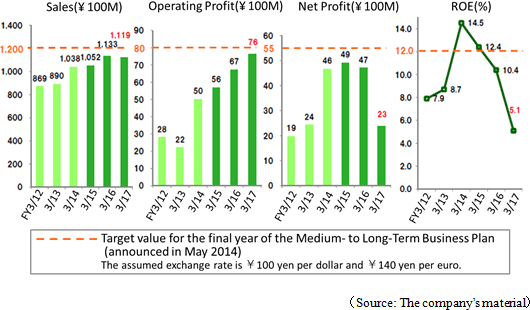 (2) Outline of "2019 Medium-term Management Plan"
The company set two visions for clearly sharing what kind of company they should aim to develop in the medium to long term.
① Basic policy and vision 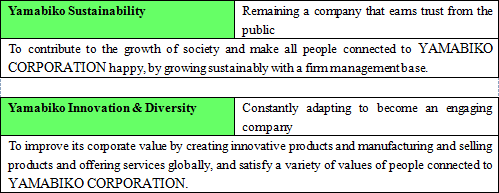 ② Key initiatives
In order to actualize the visions set in the above basic policy, the company will take the following key initiatives.
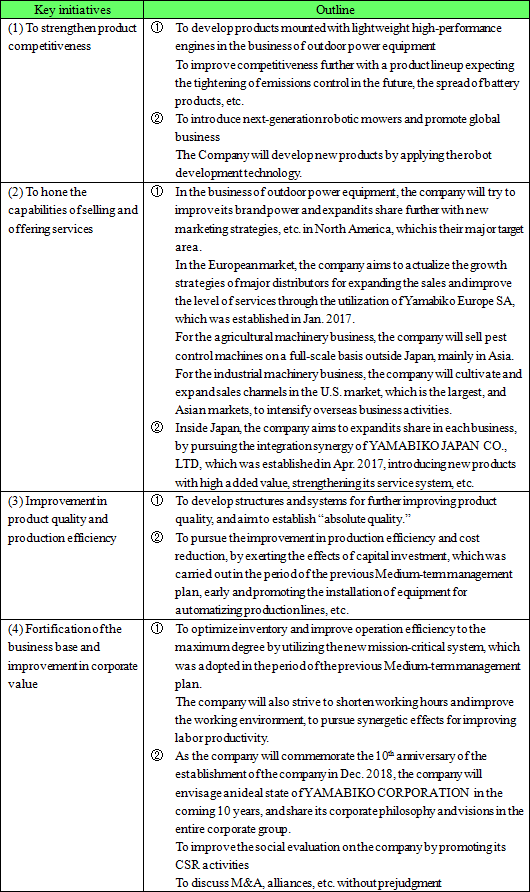 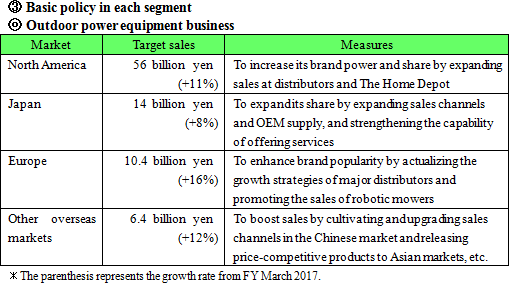 The company will keep further cultivating the market of billboard ads at stadiums of Major League Baseball (MLB) and Major League Soccer (MLS), etc. targeted at homeowners, produce and air commercials for introducing a new corporate image, and conduct sales promotion targeted at professionals. The company will also promote the sales of accessories, which are highly profitable, and utilize sales networks. (Europe) The company will operate "Yamabiko Europe SA," which was renamed in parallel with the strengthening of its selling function in Jan. 2017, on a full-scale basis. Primary measures are to actualize the growth strategies of major distributors, promote the sales of robotic mowers, and strengthen digital marketing. As for robotic mowers, the company will release a new type of evolved mowers. The robotic mower market is growing with an estimated annual growth rate of 20% (for the volume of shipments). At present, the company sells robotic mowers mainly in Europe, but it will actively cultivate the U.S. market, too, while considering that there is a significant business chance there. 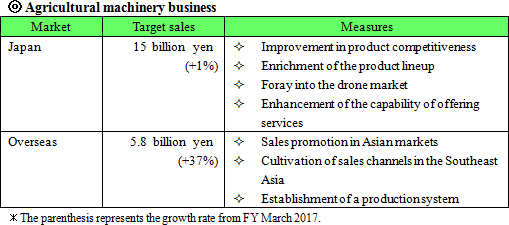 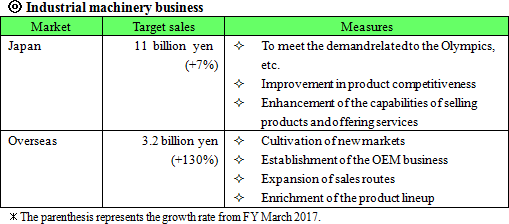 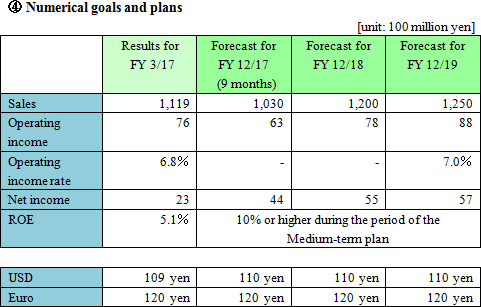 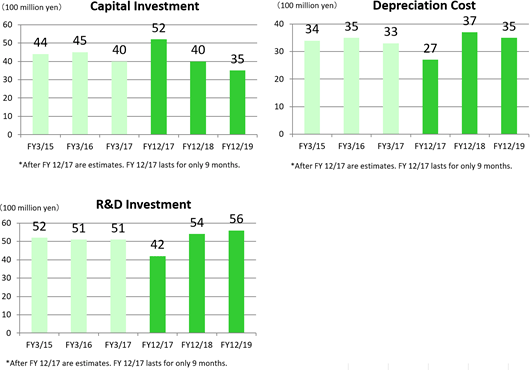 ⑤ Regarding the return to shareholders
As the company will keep paying dividends stably and its consolidated financial standing is improving, the company has decided to change the target consolidated payout ratio from "about 25%" for the previous Medium-term Management Plan to "25% or higher" for the new Medium-term Management Plan.
|
| Interview with President Nagao |
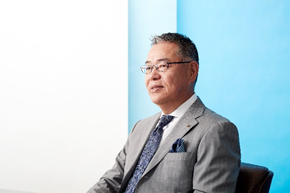 Q: "Looking back at the 2017 Medium-term Management Plan, what did you achieve, and were there any elements that were not fulfilled?"
A: "I feel rather ashamed that both sales and profit were below the original plan, but I am confident that we were able to prepare various measures solidly to lead us into the next term."
Having said that, we were able to increase revenue on the foreign currency basis in our main business of outdoor power equipment due to the effect of our marketing strategies in the U.S. and Western European markets, and the domestic performance was quite solid too. We also managed to stick to our plan with the high-level investments aimed at increasing output, improving product competitiveness and streamlining productivity through investments in automation and shortening of production lines, in addition to the measures to strengthen the sales by establishing the European HQ and integrating domestic sales affiliates. And now with the system to run the PDCA cycle effectively fully implemented, our business foundation is being steadily fortified. Therefore I am confident that we were able to prepare various measures solidly to lead us into the next term. Q: "In the new 2019 Medium-term Management Plan, you have proposed two visions. Could you explain the background and your ideas behind these visions?"
A: "Numbers are important of course, but I thought it even more important to share the visions of 'an ideal state as a company'. My idea was to put emphasis on the meaning of the reform and diversity in order to realize a sustained growth."
Our previous Medium-term Plans concentrate on the numbers in the environment of continuous growth, but in discussing with the management team, we have come to the conclusion that, numbers are important of course, but in this era in which we are expected to work towards a sustained growth in a relationship of trust with various stakeholders, it is necessary first and foremost to project our vision of "how we want to be, and should be, as a company" before talking about numbers. Our company has always put an utmost importance on the quality of our products, so as not to betray the expectations of our customers. We value honesty; dishonesty is out of question. Therefore our first vision is "Yamabiko Sustainability" to confirm and realize these qualities afresh. However, unless we can actually sustain a healthy growth as a company, it would not be possible to satisfy all stakeholders. So how are we going to achieve that? So our second vision is "Yamabiko Innovation & Diversity". Our company has been able to grow relatively steadily by increasing our market share both within Japan and in the U.S. But there is no future for us if we were to just sit on the past successes and continue with the view that tomorrow is just another extension of today. It is important to pursue innovations not only in new product developments but also different approaches in how each and every employee works. For this reason, innovation is the most important keyword for me. At the same time, diversity - to respect and take the diverse values seriously without being tied to the ideas of highly limited number of people or groups - is indispensable for a sustained growth. From this point of view, it is certainly one of the successful examples of diversity that the awareness within the company on the governance of our management team is growing, being stimulated by the outside directors' views and opinions. It is important that these visions be implemented through all ranks of the company, and not just trumpeting them. So the management will take every opportunity to repeat these messages and we will set up the platforms for the employees so they can discuss how they want to be and should be, and in doing so we will endeavor to share and truly understand the concrete images of these two visions. Q: "Please tell us the most significant points from the key initiatives included in the new Medium-term Management Plan."
A: "In these three years, we shall thoroughly reap the benefit of the investments which we have been making. We will go deeper into the U.S. market, do a full-scale launch of robotic mowers, and strengthen our product development capabilities."
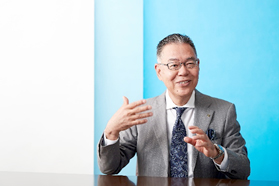 We will continue to dig deeper into the homeowner market there but we are also planning to fortify sales targeting the professional markets. The biggest factor behind our success in increasing share in the US market is the high quality of our products, which is one of our primary competitive advantages. With new image advertisements and other methods, we are going to emphasis and appeal our high-quality products to the professionals. We will also charge the U.S. market with a renewed vigor by injecting new products etc. so that we can expand sales of high-profitability accessories and parts even further. From the point of view to reap the fruit of the investments made during the previous Medium-term Management Plan, one of the most important areas has to the full-scale launch of "robotic mowers". We are already selling our first generation machines and we are making reasonable returns but to expand into the global market we have many hurdles we have to overcome such as the regulations varying among countries. We will resolve these problems one by one so we can launch the next-generation robotic mowers as soon as possible. Both in the European market, which has strict environmental regulations concerning the engines and the U.S. market, which holds numerous football and baseball stadiums, the robotic mowers are currently virtually unknown and they are superbly attractive as potential giant markets. We will also work hard to brush up our product development capabilities - our lifeline. Especially about engines, we are of course watching the overall trends seen in the automobile industries, such as the shift from engine drive to motorization driven by the environmental problems. But with the machines using the small engines developed by us, we believe that the potential growth margin is still huge globally speaking, as long as we are able to offer the products wanted by the clients in all the countries at the right times. Utilizing 3D printers, installing cutting-edge CAD and analytic technologies, and employing and injecting the most suited personnel will all contribute to the shortening of a lead-time; and this idea of working out how to achieve a speedy product development is one of the most crucial points we would be focusing on during the next Medium-term Management Plan. Q: "Finally, do you have any messages for stockholders and investors?"
A: "We envision a company that is attractive to all stakeholders. Please support us from the medium- and long-term points of view."
To live up to your high expectations, we will continue to work to make our company attractive to all stakeholders through sustained and solid growth in sales and improved profitability. So please continue supporting us from the medium- and long-term viewpoints. |
| Conclusions |
|
In the new Medium-term plan, we would like to pay attention to their efforts to improve profitability to achieve an operating income rate of 7%, as well as the growth of sales through the further cultivation of the U.S. market, the full-scale export of robotic mowers, etc. |
| <Reference: Concerning corporate governance> |
 ◎ Corporate Governance Report
The company submitted its latest corporate governance report on June 30, 2016.
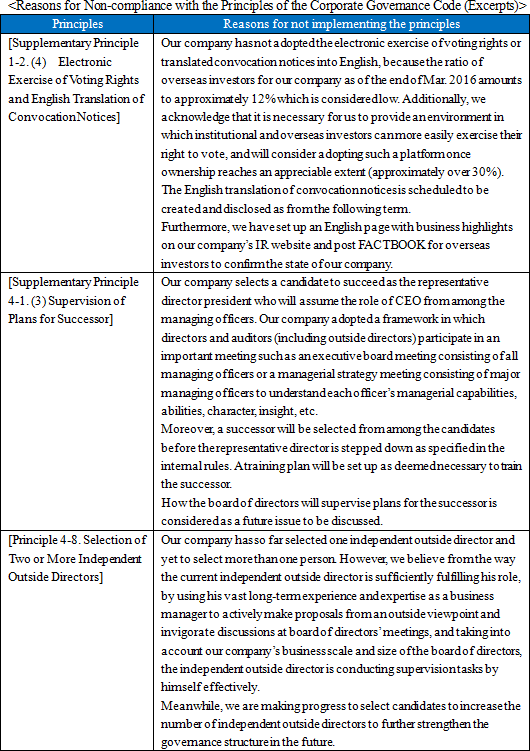 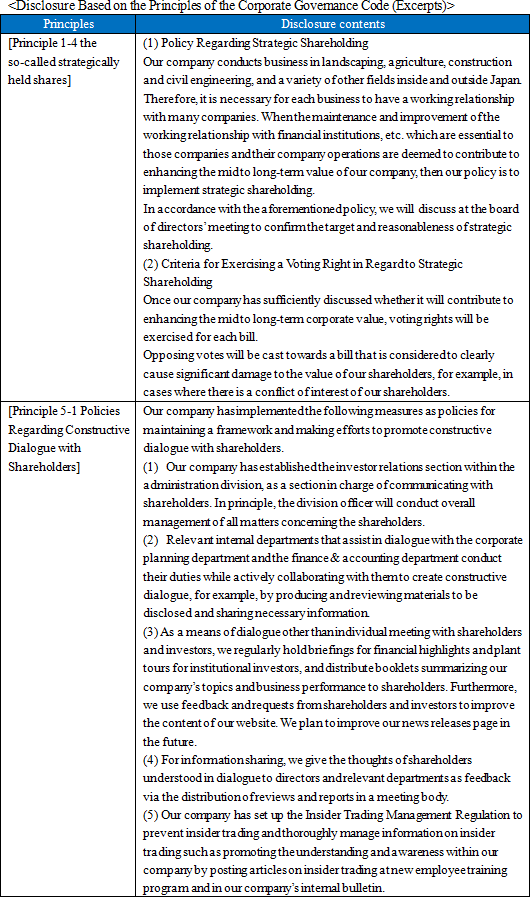 Disclaimer
This report is intended solely for information purposes, and is not intended as a solicitation for investment. The information and opinions contained within this report are made by our company based on data made publicly available, and the information within this report comes from sources that we judge to be reliable. However we cannot wholly guarantee the accuracy or completeness of the data. This report is not a guarantee of the accuracy, completeness or validity of said information and opinions, nor do we bear any responsibility for the same. All rights pertaining to this report belong to Investment Bridge Co., Ltd., which may change the contents thereof at any time without prior notice. All investment decisions are the responsibility of the individual and should be made only after proper consideration.Copyright (C) 2017 Investment Bridge Co., Ltd. All Rights Reserved. |

